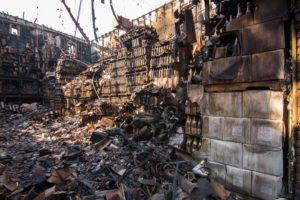Some wineries lose their entire vintage

By Dan & Krista Stockman
Wildfires in California’s wine regions are becoming increasingly common.
In 2017, wildfires burned parts of Napa Valley with six wineries damaged or destroyed.
The 2020 wildfires – known as the Glass Fire – were dramatically worse. The San Francisco Chronicle reports at least 27 wineries were damaged, with many of them destroyed.
And that’s not all – even wineries that were not burned may have lost their entire 2020 vintage because the heavy smoke from the fires ruined the grapes still on the vines, giving them an unpleasant flavor called Smoke Taint. Many wineries in the Napa and Sonoma Valleys will make no wine at all, others will make only a fraction of what they had planned, the Chronicle said. And it’s not just Napa and Sonoma – statewide, the California harvest will be about 15 percent smaller than 2019.
Sometimes, according to the Chronicle, grapes may initially appear to be fine at harvest, only to display Smoke Taint during the winemaking process, meaning even more wine will be wasted or not even made.
Smoke from the wildfires was a problem in Oregon, too, but The Oregonian reports that some winemakers were able to make good wine anyway, most often by using carbonic maceration, where the whole grapes are sealed in a fermenter filled with carbon dioxide, so fermentation begins from the natural enzymes inside the grapes rather than from added yeast. Apparently, the smoke flavors are in the skins, so this method lets fermentation begin before they’re crushed, so that when the grapes are finally pressed, the skins can be removed immediately before the smoke can contaminate the juice.
Vineyards are very fire resistant, but they’re not impervious to it, and many California wineries will have to replant burned vineyards, which take years to begin producing fruit.
All of these are devastating, but there was one damaged winery in particular that caught our attention: Castello di Amorosa, one of the many wineries we visited while in Napa for our 10th Anniversary, 10 years ago.
Castello di Amorosa is not just any Napa winery: it is a 13th century-style Tuscan castle that took 15 years to build. Construction took more than 8,000 tons of hand-chiseled local stone and nearly a million antique bricks imported from Europe. It has 107 rooms on eight levels – four of which are underground, including the torture chamber. It has a moat, drawbridge, five towers, high defensive ramparts, courtyards and loggias, a chapel, stables, and an armory. And it is home to an excellent winery with gorgeous vaulted wine cellars.
But on Sept. 28, the Glass Fire reached Castello di Amorosa and destroyed the farmhouse building, a 15,000 square-foot building about 50 yards from the castle. Most of the wine is stored in the castle cellars or in an offsite warehouse, but the Farmhouse building did hold about 120,000 bottles of wine, a bottling line, offices and a lab. Owner Dario Sattui estimates rebuilding will take two to three years – most of the materials have to come from Europe – and cost up to $12 million. The castle was unharmed, and reopened to visitors quickly.
It’s just one more reminder of what makes wine so special – when it’s made right, it is a labor of love, a work of art that reflects both the place it was grown and the hands that made it. Yes, you can make wine on an industrial scale, but the wines we love are different because they’re supposed to be different. Castello di Amarosa – from the castle to the excellent wine created there – is definitely different.
We feel awful for the damage the winery suffered but are grateful it wasn’t worse. All of the wineries damaged by the fires are different, and each is experiencing a loss far deeper than just the financial impact.
When wine is made from the heart, there is always the risk that heart will be broken: Bad weather, disease or even wildfires can destroy an entire vintage or even an entire winery.
But hearts can heal. Vines can be replanted and wineries can be rebuilt. Each and every vintage has a story to tell, and they’re not always happy, but as long as those stories are told, we’re doing something right. The story of 2020 is a devastating one in so many ways, but we will tell that story. And the 2020 wines we drink will be part of that, for better or worse.
Cheers!